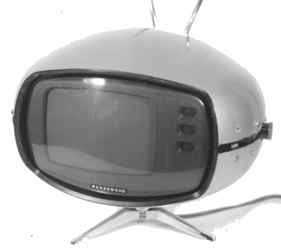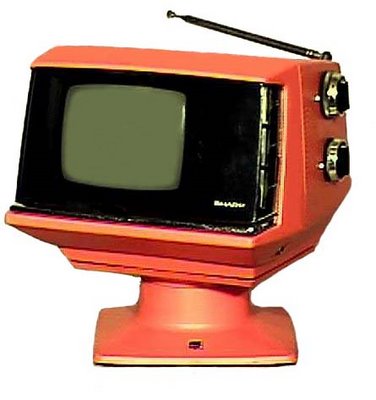 Philco Continental (1960) - Model 4370 - Danish style mahogany wood cabinet. This 21" television was the last model offered in the innovative "Predicta" series. Released to the marketplace with little advertising (due to budget constraints), consequently, few were sold. The overall series of sets had reliability problems, foremost being the specially designed 'short-neck' picture tube. Image Credit: tvhistory.tv - Copyright MZTV Museum
Philco Continental (1960) - Model 4370 - Danish style mahogany wood cabinet. This 21" television was the last model offered in the innovative "Predicta" series. Released to the marketplace with little advertising (due to budget constraints), consequently, few were sold. The overall series of sets had reliability problems, foremost being the specially designed 'short-neck' picture tube. Image Credit: tvhistory.tv - Copyright MZTV MuseumUnlicensed Radio Frequencies Gain Space In Technology Shift
There was a time when one wanted to implement a radio based communications strategy, one had to do a site survey to see what frequencies were being used, apply for a license from the Federal Communications Commission (FCC), and once approved, set the devices used to the specific frequency and hope that there we no conflicts with other radio based devices that might roam into ones radio space.
Pressure to open up radio communications applications and the advent of frequency hopping/threading management technology helped to open up the use of frequencies that did not require a license from the FCC.
 TR-005 Panasonic "Flying Saucer" TV (1971) - Image Credit: tvhistory.tv
TR-005 Panasonic "Flying Saucer" TV (1971) - Image Credit: tvhistory.tvFast forward twenty (or so) years and technology advances combined with FCC policies that recognize the shift in available frequencies, a new world of unlicensed frequency band applications is set to be available in 2009 when Television goes digital.
Excerpts from ARS Technica -
FCC opens up "white spaces" to consumer electronics
by Nate Anderson - ARS Technica - 10/13/2006
The FCC officially signed off on the plan to allow low-power wireless devices to operate in so-called "white spaces" in the television spectrum. The Commission laid out a roadmap for this plan last month, but only issued the "First Report and Order" that actually authorizes it yesterday.
Here's how the scheme will work: consumer electronics devices will be allowed to operate in the portion of the TV spectrum being vacated by broadcasters as they switch to digital broadcasts in 2009, with some restrictions. Channel 37 is out - it's used by radio astronomers. Channels 52-69 are also out, since they have been allocated for public safety use. Finally, channels 14-20 might be out (the Commission has asked for more information) because 13 US cities currently use parts of that spectrum for public safety communications.
 Sharp 5 inch B&W Transistorized TV (1981) - Image Credit: tvhistory.tv
Sharp 5 inch B&W Transistorized TV (1981) - Image Credit: tvhistory.tvWhile manufacturers can begin to design and certify their devices in the next few months, they cannot go on sale until February 18, 2009. Even though the spectrum in question should be available after that date, the FCC is still concerned that unlicensed devices in the band might generate interference that could affect the digital TV signals, and they plan to conduct extensive internal testing (and possibly adopt more rules) to ensure that this doesn't happen.
The Commission also mandated a dynamic frequency selection mechanism be built into every device, so that it does not interfere with other devices in the immediate vicinity. It may also decide to enforce the "geo-location" rules ...
----
... where a professional installer (or the devices themselves) would use GPS to check the installed location against a database in order to avoid potential interference.
Implications
This was a decision that was easy for the commissioners to like. Michael Copps, one of the two Democrats on the Commission, pointed out that the US is falling behind in broadband - the International Telecommunications Union ranks us at number 15. Copps believes that opening up a new chunk of spectrum will help pave the way for wireless broadband services like WiMAX that can help bring broadband to more Americans. "Make no mistake about it," he says, "it is a very grave situation. There is simply no way that our country can remain in the forefront of the global economy without developing a broadband infrastructure that is up to the task."
----
"With our recent AWS auction and the upcoming 700Mhz auction," he says, "we are opening up a huge swath of prime spectrum to licensed use - and it seems to me, on the present record, that the appropriate balance is to open up the TV white spaces to unlicensed use."
 JVC Model 3100D - "Pyramid" with clock - Transistorized - Approx 7" Screen which folds down (1978)
JVC Model 3100D - "Pyramid" with clock - Transistorized - Approx 7" Screen which folds down (1978)The approach that is ultimately chosen will have a huge effect on the uses that the spectrum is put to: Just think of the success of cordless phones and WiFi, two wildly successful wireless technologies that have taken advantage of unlicensed spectrum. On the other hand, think of the interference issues that result when your 2.4GHz cordless phone rings and disconnects your WiFi - welcome to the downside of unlicensed spectrum.
Read All>>
Obviously, the opening up of unlicensed frequencies for consumer electronics use opens up these "freqs" for business applications hardware as well.
No comments:
Post a Comment